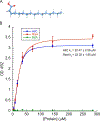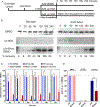AraC-type regulators HilC and RtsA are directly controlled by an intestinal fatty acid to regulate Salmonella invasion
- PMID: 34687258
- PMCID: PMC8688230
- DOI: 10.1111/mmi.14835
AraC-type regulators HilC and RtsA are directly controlled by an intestinal fatty acid to regulate Salmonella invasion
Abstract
Invasion of the intestinal epithelium is an essential but energetically expensive survival strategy and is, therefore, tightly regulated by using specific cues from the environment. The enteric pathogen Salmonella controls its invasion machinery through the elegant coordination of three AraC-type transcription activators, HilD, HilC, and RtsA. Most environmental signals target HilD to control invasion, whereas HilC and RtsA are known only to augment these effects on HilD. Here we show that a fatty acid found in the murine colon, cis-2-hexadecenoic acid (c2-HDA), represses Salmonella invasion by directly targeting HilC and RtsA, in addition to HilD. c2-HDA directly binds each of these regulators and inhibits their attachment to DNA targets, repressing invasion even in the absence of HilD. Fatty acid binding, however, does not affect HilC and RtsA protein stability, unlike HilD. Importantly, we show that HilC and RtsA are highly effective in restoring HilD production and invasion gene expression after elimination of the repressive fatty acid c2-HDA. Together, these results illuminate a precise mechanism by which HilC and RtsA may modulate invasion as Salmonella navigates through different regions of the intestine, contributing to our understanding of how this enteric pathogen senses and adapts to a diverse intestinal environment while maintaining its virulence.
Keywords: Salmonella; enteric diseases; fatty acids; host-pathogen interactions.
© 2021 John Wiley & Sons Ltd.
Conflict of interest statement
VII. Conflict of Interest
None.
Figures





Similar articles
-
Diffusible Signal Factors Act through AraC-Type Transcriptional Regulators as Chemical Cues To Repress Virulence of Enteric Pathogens.Infect Immun. 2020 Sep 18;88(10):e00226-20. doi: 10.1128/IAI.00226-20. Print 2020 Sep 18. Infect Immun. 2020. PMID: 32690633 Free PMC article.
-
HilD, HilC, and RtsA Form Homodimers and Heterodimers To Regulate Expression of the Salmonella Pathogenicity Island I Type III Secretion System.J Bacteriol. 2020 Apr 9;202(9):e00012-20. doi: 10.1128/JB.00012-20. Print 2020 Apr 9. J Bacteriol. 2020. PMID: 32041797 Free PMC article.
-
HilD, HilC and RtsA constitute a feed forward loop that controls expression of the SPI1 type three secretion system regulator hilA in Salmonella enterica serovar Typhimurium.Mol Microbiol. 2005 Aug;57(3):691-705. doi: 10.1111/j.1365-2958.2005.04737.x. Mol Microbiol. 2005. PMID: 16045614
-
Adaptation to the host environment: regulation of the SPI1 type III secretion system in Salmonella enterica serovar Typhimurium.Curr Opin Microbiol. 2007 Feb;10(1):24-9. doi: 10.1016/j.mib.2006.12.002. Epub 2007 Jan 5. Curr Opin Microbiol. 2007. PMID: 17208038 Review.
-
Salmonella invasion gene regulation: a story of environmental awareness.J Microbiol. 2005 Feb;43 Spec No:110-7. J Microbiol. 2005. PMID: 15765064 Review.
Cited by
-
Major primary bile salts repress Salmonella enterica serovar Typhimurium invasiveness partly via the efflux regulatory locus ramRA.Front Microbiol. 2024 Feb 12;15:1338261. doi: 10.3389/fmicb.2024.1338261. eCollection 2024. Front Microbiol. 2024. PMID: 38410385 Free PMC article.
-
Recombinant production of a diffusible signal factor inhibits Salmonella invasion and animal carriage.Gut Microbes. 2023 Jan-Dec;15(1):2208498. doi: 10.1080/19490976.2023.2208498. Gut Microbes. 2023. PMID: 37158497 Free PMC article.
-
Epigallocatechin gallate protects mice from Salmonella enterica ser. Typhimurium infection by modulating bacterial virulence through quorum sensing inhibition.Front Cell Infect Microbiol. 2024 Oct 16;14:1432111. doi: 10.3389/fcimb.2024.1432111. eCollection 2024. Front Cell Infect Microbiol. 2024. PMID: 39479281 Free PMC article.
-
Anti-infective activities of long-chain fatty acids against foodborne pathogens.FEMS Microbiol Rev. 2023 Jul 5;47(4):fuad037. doi: 10.1093/femsre/fuad037. FEMS Microbiol Rev. 2023. PMID: 37437907 Free PMC article. Review.
-
Salmonella Invasion Is Controlled by Competition among Intestinal Chemical Signals.mBio. 2023 Apr 25;14(2):e0001223. doi: 10.1128/mbio.00012-23. Epub 2023 Apr 5. mBio. 2023. PMID: 37017539 Free PMC article.
References
-
- Ackermann M, Stecher B, Freed NE, Songhet P, Hardt W-D, and Doebeli M (2008) Self-destructive cooperation mediated by phenotypic noise. Nature 454: 987–990. - PubMed
-
- Altier C, Suyemoto M, Ruiz AI, Burnham KD, and Maurer R (2000) Characterization of two novel regulatory genes affecting Salmonella invasion gene expression. Mol Microbiol 35: 635–646. - PubMed
Publication types
MeSH terms
Substances
Grants and funding
LinkOut - more resources
Full Text Sources
Medical
Miscellaneous

